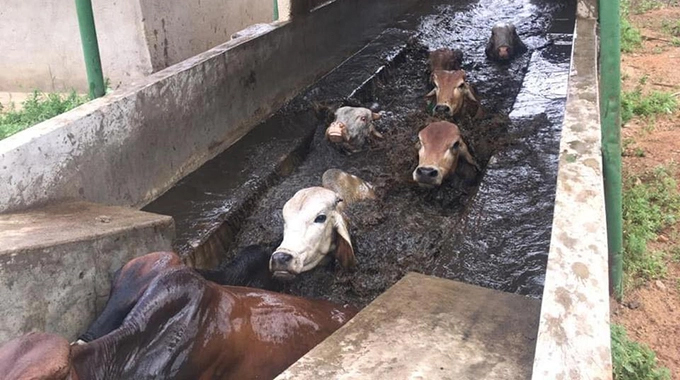
The ManicaPost

Samuel Kadungure
Senior Reporter
AN acute shortage of water in drier regions of Manicaland is threatening to disrupt cattle dipping as farmers and veterinary authorities fail to fill up some dip tanks,thereby putting the livestock at risk of contracting tick-borne diseases as summer approaches and temperatures rise.
Areas in Regions Three, Four and Five are running short of water and pastures for their livestock owing to the low rains received last season.
Animal health experts who spoke to The Manica Post this week said cattle risk succumbing to disease outbreaks this summer, as well as shortages of water and pastures.
Most small-holder farmers often experience challenges in availing adequate feed and water for their livestock during this period.
The most prominent constraint in livestock farming, apart from diseases, is the quality of feed offered to the animals.
Experts are therefore encouraging farmers to de-stock and use the money to acquire vitamin supplements and drugs for their livestock.
Manicaland Provincial Veterinary Officer, Dr Charles Guri said while they are encouraging farmers to dip their cattle religiously to control the spread of theileriosis, commonly referred to as January disease, water challenges are threatening to erode all the gains made so far to ensure the health of the provincial herd.
Dr Guri said adequate dipping chemicals are available, thanks to Government’s initiative to distribute one million kilogrammes of tick grease to livestock farmers under the Presidential Livestock Inputs Scheme, but shortages of water in natural Regions Three, Four and Five are giving them headaches.
He said the only available option at the moment — distribution of pour-on dipping chemical — is expensive.
“We are facing water challenges and filling up communal dip tanks in the dry regions is proving to be a tall order. Manicaland has 549 dip tanks and more than 250 dip tanks are affected by this water problem.
“Dipping chemicals are readily available, but there is no water, which means no dipping will take place. This will give ticks time to grow into adult ticks and these will spread diseases as we go into September.
“The alternative pour-on dip chemical is expensive and we may not be able to service all affected communal dip tanks using this route,” said Dr Guri.
He said this will disrupt efforts to combat January disease, which has turned out to be the biggest evil facing livestock farmers, killing thousands of cattle, even outside the rainy season.
Not so long ago, the disease saw communal farmers accruing huge losses as they helplessly watched their cattle die.
Dr Guri said although January disease, foot and mouth and anthrax are currently under control in Manicaland, farmers need to de-stock to avoid mass cattle deaths.
This comes as the provincial grazing adequacy map, which monitors cattle grazing lands to reduce cattle mortality, indicated that both pastures and water are in short supply.
“The body condition of animals has deteriorated and farmers should not mislead themselves into believing that they will be able to feed these animals. Animals that will not be in good condition in the coming two or three months must be de-stocked so that farmers remain with animals they are able to look after.
“Supplementary feeding should be prioritized until we get the first rains. When farmers de-stock, they should invest the proceeds in supplementary feeds for the remaining herd, as well as in vaccines for diseases like blackleg and anthrax,” he said.
With little or no savings, communal farmers are confronted by shortage of drugs and supplementary stock feed to improve the health of their animals.
A survey conducted by The Manica Post revealed that most rural farmers are using raw dry maize stalks (mashanga) to feed their cattle.
Following crop harvesting, most communal farmers let their cattle loose to feed on crop residues, a method which goes against the ethos of the commercial production system where cattle are kept in paddocks, grazing is a controlled environment which is aided by vitamin supplements.
Animal health expert, Professor Joseph Kamuzhanje said dry grass and maize stalks are not nutritious.
“The dry crop residues are bereft of nutrients, and their intake by animals is low, which limit production. Farmers should invest in supplementary commercial feeds or improved legume fodder to improve livestock productivity.
“Since the stock feed is restricted, communal animals have little choice when it comes to feeding, resulting in poor body condition, low weight gains and a higher predisposition to endo-parasites during the dry season,” said Prof Kamuzhanje.
“The crop residues have low nutritional value — only six percent protein — if taken as they are. However, the farmers can still improve the quality and digestibility of stovers through a three-week fermentation using a urea-water solution,” he said.
The crude protein content of stovers increase when treated with urea.



